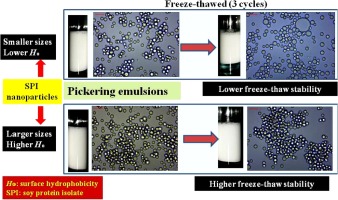当前位置:
X-MOL 学术
›
Food Hydrocoll.
›
论文详情
Our official English website, www.x-mol.net, welcomes your
feedback! (Note: you will need to create a separate account there.)
Improving Freeze-thaw Stability of Soy Nanoparticle-stabilized Emulsions through Increasing Particle size and Surface Hydrophobicity
Food Hydrocolloids ( IF 11.0 ) Pub Date : 2019-02-01 , DOI: 10.1016/j.foodhyd.2018.08.020 Ye-Bao Chen , Xue-Feng Zhu , Tong-Xun Liu , Wei-Feng Lin , Chuan-He Tang , Ruihai Liu
Food Hydrocolloids ( IF 11.0 ) Pub Date : 2019-02-01 , DOI: 10.1016/j.foodhyd.2018.08.020 Ye-Bao Chen , Xue-Feng Zhu , Tong-Xun Liu , Wei-Feng Lin , Chuan-He Tang , Ruihai Liu

|
Abstract There is increasing interest in improving the freeze-thaw stability of emulsions by interfacial engineering in the food colloid field. The present work reported that for Pickering emulsions stabilized by heat-induced soy protein isolate (SPI) nanoparticles, their freeze-thaw stability could be well modulated by modifying the characteristics of the nanoparticles. The SPI nanoparticles with different characteristics (e.g., particle size, surface hydrophobicity) were obtained by heating the SPI solutions at initial concentrations (ci) of 0.25–6.0 wt% at 95 °C for 15 min. All the initial Pickering emulsions were formed at an oil fraction of 0.4 and protein concentration of 0.25 wt% in the aqueous phase, in the presence of 300 mM NaCl. In general, increasing the ci resulted in a progressive enhancement in freeze-thaw stability of the emulsions against creaming and coalescence, but accelerated the flocculation. The higher creaming stability at higher ci values seemed to be closely associated with the enhanced coalescence stability, as well as the strengthened gel-like network of these initial emulsions. There were close interplays between the freeze-thaw stability and the properties of the initial emulsions, or characteristics (e.g. particle size or surface hydrophobicity) of heat-induced SPI nanoparticles. The results confirmed that the SPI nanoparticles with larger sizes, higher surface hydrophobicity and more efficient packing at interface exhibit a greater potential to produce Pickering emulsions with higher freeze-thaw stability. The findings would be of relevance for understanding the freeze-thaw stability of Pickering emulsions stabilized by protein-based particles, as well as for the development of protein-stabilized emulsion formulations with a high freeze-thaw stability.
中文翻译:

通过增加粒径和表面疏水性提高大豆纳米颗粒稳定乳液的冻融稳定性
摘要 在食品胶体领域,通过界面工程提高乳液的冻融稳定性越来越受到关注。目前的工作报告说,对于由热诱导大豆分离蛋白 (SPI) 纳米颗粒稳定的 Pickering 乳液,它们的冻融稳定性可以通过改变纳米颗粒的特性来很好地调节。通过将初始浓度 (ci) 为 0.25–6.0 wt% 的 SPI 溶液在 95 °C 下加热 15 分钟,可以获得具有不同特性(例如,粒径、表面疏水性)的 SPI 纳米颗粒。在 300 mM NaCl 存在下,所有初始 Pickering 乳液均在水相中以 0.4 的油分数和 0.25 wt% 的蛋白质浓度形成。一般来说,增加 ci 导致乳液的冻融稳定性逐渐增强,以防止乳油化和聚结,但会加速絮凝。较高 ci 值下较高的乳膏化稳定性似乎与增强的聚结稳定性以及这些初始乳液的增强的凝胶状网络密切相关。冻融稳定性与初始乳液的性质或热诱导的 SPI 纳米粒子的特性(例如粒径或表面疏水性)之间存在密切的相互作用。结果证实,具有更大尺寸、更高表面疏水性和更有效界面堆积的SPI纳米粒子具有更大的潜力来生产具有更高冻融稳定性的Pickering乳液。
更新日期:2019-02-01
中文翻译:

通过增加粒径和表面疏水性提高大豆纳米颗粒稳定乳液的冻融稳定性
摘要 在食品胶体领域,通过界面工程提高乳液的冻融稳定性越来越受到关注。目前的工作报告说,对于由热诱导大豆分离蛋白 (SPI) 纳米颗粒稳定的 Pickering 乳液,它们的冻融稳定性可以通过改变纳米颗粒的特性来很好地调节。通过将初始浓度 (ci) 为 0.25–6.0 wt% 的 SPI 溶液在 95 °C 下加热 15 分钟,可以获得具有不同特性(例如,粒径、表面疏水性)的 SPI 纳米颗粒。在 300 mM NaCl 存在下,所有初始 Pickering 乳液均在水相中以 0.4 的油分数和 0.25 wt% 的蛋白质浓度形成。一般来说,增加 ci 导致乳液的冻融稳定性逐渐增强,以防止乳油化和聚结,但会加速絮凝。较高 ci 值下较高的乳膏化稳定性似乎与增强的聚结稳定性以及这些初始乳液的增强的凝胶状网络密切相关。冻融稳定性与初始乳液的性质或热诱导的 SPI 纳米粒子的特性(例如粒径或表面疏水性)之间存在密切的相互作用。结果证实,具有更大尺寸、更高表面疏水性和更有效界面堆积的SPI纳米粒子具有更大的潜力来生产具有更高冻融稳定性的Pickering乳液。











































 京公网安备 11010802027423号
京公网安备 11010802027423号